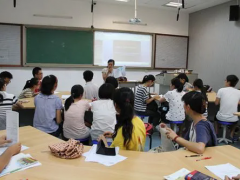英语谚语中的倒装
1.英语句子中的倒装形式
nor是表示否定的副词,如果它放在句首,句子必须半倒装
英语倒装分为“半倒装”就是系动词助动词情态动词提前的,例如你上面的句子呈现“否定词,助动词,主语,实意动词(即谓语动词)”结构。
和“完全倒装”。完全倒装是指“句子的主语与谓语动词倒装”
例如我下面的句子:“Here comes the bus.”这个句子bus是主语,她就放在了谓语动词come的后面,句子呈现“谓语主语”结构,而不是传统的“主语维语”结构。
2.英语中的倒装
是很宏大,分类如下:
1. 疑问句。 这个不说了。
2. 祝愿句。 Long live peace/chairman Mao!
3. 某些感叹句。 There goes the bell. Here comes the bus!
4. There be 结构。 There lived a king who likes horsed very much.
5. 直接引语位于句首的陈述句。 “It's quite late,” said Tonny.
6. 地点状语位于句首、主语为名词而谓语为不及物动词的陈述句。
From the window came sound of music.
7. 某些条件从句。 Had I the time, I would go. Were you in my opinion, you would do the same.
8. 某些让步从句。
Tired as he is, he goes on.
9. 代词so, neither, nor 等副词位于句首时,常需倒装。
If you can do it, so can I. I don't know, nor do I care.
10. never, seldom, little, nor, hardly, scarcely, no sooner, not only等表示否定的副词或连词位于句首时,常需倒装。
Never in my life have I seen such a thing.
No sooner had he arrived than he fell ill.
11. only 位于句首并后跟状语时。
only then did I understand it.
12. 主语部分较长需要后置时。
They erect a bronze tablet on which is carved "The Yellow River Source."
13. 为了上下文的衔接。
“Now, I have no opinion of that policy.”
3.英语中的倒装是什么意思用在什么句子中
主语和谓语是句子的核心,它们之间有两种语序:一是主语在谓语之前称为自然语(Natural Order);二是主语在谓语之后则称为倒装语序(Inverted Order)。
而倒装语序中又有全部倒(Full Inversion)和部分倒装(Partial Inversion)两种情况。 1. 倒装句之全部倒装 全部倒装是只将句子中的谓语动词全部置于主语之前。
此结构通常只用与一般现在时和 一般过去时。常见的结构有: 1) here, there, now, then, thus等副词置于句首, 谓语动词常用be, come, go, lie, run。
There goes the bell. Then came the chairman. Here is your letter. 2) 表示运动方向的副词或地点状语置于句首,谓语表示运动的动词。 Out rushed a missile from under the bomber. Ahead sat an old woman. 注意:上述全部倒装的句型结构的主语必须是名词,如果主语是人称代词则不能完全倒装。
Here he comes. Away they went. 2. 倒装句之部分倒装 部分倒装是指将谓语的一部分如助动词或情态倒装至主语之前。如果句中的谓语没有助动词或情态动词,则需添加助动词do, does或did,并将其置于主语之前。
1) 句首为否定或半否定的词语,如no, not, never, seldom, little, hardly, at no time, in no way, not until… 等。 Never have I seen such a performance. Nowhere will you find the answer to this question. Not until the child fell asleep did the mother leave the room. 当Not until引出主从复合句,主句倒装,从句不倒装。
注意: 如否定词不在句首不倒装。 I have never seen such a performance. The mother didn't leave the room until the child fell asleep. 典型例题 1) Why can't I smoke here? At no time___ in the meeting-room A. is smoking permitted B. smoking is permitted C. smoking is it permitted D. does smoking permit 答案A. 这是一个倒装问题。
当否定词语置于句首以表示强调时,其句中的主谓须用倒装结构。 这些否定词包括no, little, hardly, seldom, never, not only, not until等。
本题的正常语序是 Smoking is permitted in the meeting-room at no time. 2) Not until the early years of the 19th century ___ what heat is. A. man did know B. man know C. didn't man know D. did man know 答案D. 看到Not until…的句型,我们知道为一倒装句,答案在C,D 中选一个。 改写为正常语序为,Man did not know what heat is until the early years of the 19th. 现在将not提前,后面就不能再用否定了,否则意思就变了。
3. 以否定词开头作部分倒装 如 Not only…but also, Hardly/Scarcely…when, No sooner… than Not only did he refuse the gift, he also severely criticized the sender. Hardly had she gone out when a student came to visit her. No sooner had she gone out than a student came to visit her. 典型例题 No sooner___ than it began to rain heavily. A. the game began B. has the game begun C. did the game begin D. had the game begun 答案D. 以具有否定意义的副词放在句首时,一般采用倒装句(谓语前置)。这类表示否定意义的词有never, seldom, scarcely, little, few, not, hardly, 以及not only…but (also), no sooner…than, hardly… when scarcely… when 等等。
注意:只有当Not only… but also连接两个分句时,才在第一个分句用倒装结构。如果置于句首的Not only… but also仅连接两个并列词语,不可用倒装结构。
Not only you but also I am fond of music. 4. so, neither, nor作部分倒装 表示"也"、"也不" 的句子要部分倒装。 Tom can speak French. So can Jack. If you won't go, neither will I. 典型例题 ---Do you know Jim quarrelled with his brother? ---I don't know, _____. A. nor don't I care B. nor do I care C. I don't care neither D. I don't care also 答案:B. nor为增补意思"也不关心",因此句子应倒装。
A错在用 don't 再次否定, C neither 用法不对且缺乏连词。 D缺乏连词。
注意: 当so引出的句子用以对上文内容加以证实或肯定时,不可用倒装结构。意为"的确如此"。
Tom asked me to go to play football and so I did. ---It's raining hard. ---So it is. 5. only在句首要倒装的情况 only in this way, can you learn English well. only after being asked three times did he come to the meeting. 如果句子为主从复合句,则主句倒装,从句不倒装 only when he is seriously ill, does he ever stay in bed. 6. as, though 引导的倒装句 as / though引导的让步从句必须将表语或状语提前 (形容词, 副词, 分词, 实义动词提前)。 注意: 1) 句首名词不能带任何冠词。
2) 句首是实义动词, 其他助动词放在主语后。如果实义动词有宾语和状语, 随实义动词一起放在主语之前。
Try hard as he will, he never seems able to do the work satisfactorily. 注意: 让步状语从句中,有though,although时,后面的主句不能有but,但是 though 和yet可连用。 。
4.英语中的倒装句都有哪些
倒装句之部分倒装 部分倒装是指将谓语的一部分如助动词或情态倒装至主语之前。
如果句中的谓语没有助动词或情态动词,则需添加助动词do, does或did,并将其置于主语之前。 一、副词here,there, in, out,up ,down, away,back,now, then, ahead 等位于句首,当谓语动词是be,come, go, follow,run等表示位置移动的动词,而且主语又是名词时,需要把谓语动词放主语之前,即全部倒装。
注意:A 此类倒装不用进行时态度。B若主语是代词时,不用倒装。
一、副词here,there, in, out,up ,down, away,back,now, then, ahead 等位于句首,当谓语动词是be,come, go, follow,run等表示位置移动的动词,而且主语又是名词时,需要把谓语动词放主语之前,即全部倒装。 注意:A 此类倒装不用进行时态度。
B若主语是代词时,不用倒装。 二,含有否定意义的词放句首,部分倒装。
三,only+状语,部分到装 四、表示上文的状况也适合另外一人或事半功倍有下列 五、as 作“尽管/虽然”,引导让步状语从句,由于语法需要,把表语/状语/动词提于句首 六、so ..that.., such ..that..的句子结构中,若so,such 和与其所修饰的词置于句首,实行部分倒。 七、若if 引导的虚拟条件句中有were, had, should 时, 可将if省,把were, had , should 放主语之前。
八、充当地点状语的介词短语放句首,全倒。 九、在表示愿望的感叹句,倒装。
十、There be 句型,。
5.英语中的倒装句分几种
一、疑问句中出现的倒装句1. 特殊疑问句中(1)What is this?(全倒装)(2)Which do you want?(部分倒装)2. 一般疑问句(1)Do you study English every day?(部分倒装) (2)May I come in? (3)Are you going to be a teacher?特殊疑问句中,如果疑问词做主语或疑问词修饰主语时,句子不用倒装,即用陈述语序。
例如:Who did it yesterday? Which guy can do this work?一般疑问句中,常把助动词或情态动词放在句首,即位于主语前,而构成部分倒装。二、感叹句中出现倒装句1. What引导的感叹句(1)What a happy life we have had!(宾语在主语前面)(2)What a fine day it is!(表语在主语前面)(3)What a shining example Comrade Lei Feng has set us!2. How引导的感叹句(1)How happy we are!(表语在前面)(2)How hard they are working!(状语在前面)(3)How nice a day it is!3. 副词引导词引导的感叹句(1)There comes the bus!(2)In come the students!(3)Off goes the worker!What或how 引导的句子,主谓也有不倒装的。
What所强调的重点是名词,这一名词一般是表语或宾语,有时所强调的名词可能是主语。例如:What enormous crowd came!(《当代英语语法》中册P87)。
What也可单独使用。例句:What she suffered in the old days!(《英语分类句型》P90)How修饰形容词、副词或动词。
有时how many的搭配也可修饰名词。For how many years have I waited! 该短语作状语。
(《当代英语语法》)副词引导词位于句首,一方面为了强调,另一方面使情景生动。主语是名词时,主谓倒装;如果主语是人称代词,主谓不倒装。
例如:Away he went to the station!三、祈使句中出现的倒装1. Long live the king! (《最新实用英汉辞典》P769)2. Long live the People's Republic of China!3. May you succeed! 祝你成功!Long may he live! 愿他长命百岁!(《英华大辞典》P780)4. Don't you open the door. Don't anyone open the door.(《当代英语语法》中册P85)祈使句一般无主语,有时也有主语出现。祈使句的主语要重读,代词也要重读(陈述句的主语一般不重读)。
祈使句常用句号。表示一种强烈感情时,句子用感叹号。
四、陈述句中出现的几种倒装句1. 主谓倒装(1)Long long ago, there was a war between the birds and the beasts.(2)once upon a time there were six blind men in India.(3)“Come along, then.” said the bird.(4)。but toward the end there came the terrible storm。
2. 表语倒装(1)Such was Albert Einstein,a simple man of great achievements.(全倒装句)(2)Inside the pyramids are the rooms for the bodies of kings and queens.(3)A very reliable person he is.(主语是人称代词时,主谓不倒装)(《英语分类句型》P400)3. 宾语倒装(1)Many happy hours she had spent planning for something nice for him.(2)Twenty-one dollars they took for it.(3)Not a single mistake did he make.(4)only a dictionary he never forgets to bring here.宾语在前时,多数属于强调部分,句子一般不加助动词,偶尔也有助动词出现,如例句(3)。五、复合句中的倒装(1)I take back what I said.(2)。
and the ship would have sunk with all board had it not been for the captain.(要是没有那位船长,就会连船带人都沉没了。)(3)Were I you,I would go with him.(4)Proud as these nobles are,he is afraid to see me.(5)Not only was everything that he had taken away from him,but also his German citizenship.(6)Hardly (Scarcely)had he sat down when the telephone rang.(7)The harder you work, the greater will be your achievement.六、其他倒装陈述句中为了保持句子平衡或为了强调表语、宾语、状语等成分,或使上下文紧密衔接时,使用倒装句。
(1)On the wall is a blackboard on which were written some words,“It is no use sitting here without listening to me.”(定语从句中,主语的同位语太长)(2)They entered the classroom,in front of which sat a naughty boy.(使上下文紧密衔接)(3)Gone forever are the days when the Chinese people were looked down upon by the foreigners.(主语加上定语后太长而表语短,所以表语在前面,强调句子平衡)。
6.什么是英语里面的倒装
简单地说,就是将动词提前,通常是为了满足句子表达结构或者需要强调时,会采用倒装表达。
1. 用于句首为下列副词的句子中:here,there,now,out,in,up,down,away,off,then,形成全部倒装。 如:Here is a ticket for you.这里有你一张票。
Down came the bird.那只鸟飞了下来。
2. 在下列副词为首的句型中,形成部分倒装。Only+副词、介词短语、状语从句或often,many a time.
如:only then did I realizethe importance of English.直到那时,我才意识到英语的重要性。
Many a time has he helped us.他曾经多次帮助过我们。
3. 用在前面所说的情况也适合于另一个人或物的肯定句或否定句中:
(1) 肯定重复倒装用so。 如:He likes swimming. So do I.他喜欢游泳,我也喜欢。
(2) 否定重复倒装用nor,neither,no more。
如:I don't agree with you. Nor do they.我不同意你们的意见.他们也不同意。
4. 用于让步状语从句中,用no matter how。,however,as。 如:Young as he is, he is good at painting very much.他虽然年轻,但很擅长绘画。







